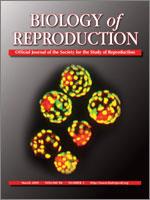Leptin plays a role in both energy homeostasis and reproduction, and it is required in early pregnancy. It stimulates metalloproteinase activity in cultured human trophoblasts and invasiveness of cultured mouse trophoblasts. Our goal has been to examine mechanisms that underpin the ability of leptin to promote trophoblast invasiveness in primary cultures of mouse trophoblasts. Leptin stimulated the phosphorylation of MEK (MAP2K1) but not signal transducer and activator of transcription 3 (STAT3) in the cultures, increased the concentration of the suppressor of cytokine signaling 3 (SOCS3) protein, and upregulated metalloproteinase activity. Microarray analysis revealed that leptin stimulated select genes with roles in cell motility, including Stmn, a gene linked to invasiveness in other cell types. There was also an increase in activity of several genes associated with MAPK and RhoGTPase signaling. In addition, leptin muted expression of genes correlated with terminal differentiation of trophoblast giant cells, including ones associated with the TGFbeta signaling pathway and endoreduplication of DNA, and upregulated selected prolactin-related family members. Feulgen staining of leptin-treated cells revealed a loss of cells with low ploidy. The data suggest that leptin accelerates disappearance of non-giant cells while inhibiting terminal differentiation of committed giant cells, possibly by maintaining cells in an intermediate stage of differentiation.
How to translate text using browser tools
1 March 2009
Effect of Leptin on Mouse Trophoblast Giant Cells
L. C. Schulz,
E. P. Widmaier,
J. Qiu,
R. M. Roberts
ACCESS THE FULL ARTICLE

Biology of Reproduction
Vol. 80 • No. 3
March 2009
Vol. 80 • No. 3
March 2009
leptin
matrix metalloproteinase
MEK
placenta
signal transduction
SOCS3
STAT3




